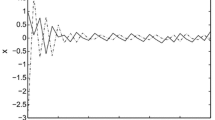Abstract
Limited capacity of communication channels has strongly pushed the analysis of control systems subject to a quantized input set. Quantized control system of type x + = x + u, where the u takes values in a set of 2m + 1 integer numbers, symmetric with respect to 0 arise in some fundamental situations, e.g., flat, nilpotent, and linear systems with quantized feedback. In this paper we consider this special type of systems and analyze the reachable set after K steps. We find explicit expressions, for each K and for each m, of m input values such that the reachable set after K steps is as large as possible.
Similar content being viewed by others
References
Alter R, Barnett JA (1980) A postage stamp problem. Am Math Monthly 87: 206–210
Bicchi A, Chitour Y, Marigo A (2004) Reachability and steering of rolling polyhedra: a case study in discrete nonholonomy. IEEE Trans Autom Control 49(5): 710–726
Bicchi A, Marigo A, Piccoli B (2006) Feedback encoding for efficient symbolic control of dynamical systems. Special Issue IEEE Trans Autom Control Symb Methods Complex Control Syst 51(6): 987–1002
Bicchi A, Marigo A, Piccoli B (2002) On the reachability of quantized control systems. IEEE Trans Autom Control 47(4): 546–563
Brockett R, Liberzon D (2000) Quantized feedback stabilization of linear systems. IEEE Trans Autom Control 45(7): 1279–1289
Chitour Y, Marigo A, Piccoli B (2005) Quantization of the rolling-body problem with applications to motion planning. Syst Control Lett 10: 999–1013
Chitour Y, Piccoli B (2001) Controllability for discrete systems with a finite control set. Math Control Signals Syst 14(2): 173–193
Delchamps DF (1989) Extracting state information from a quantized output record. Syst Control Lett 13: 365–371
Delchamps DF (1990) Stabilizing a linear system with quantized state feedback. IEEE Trans Autom Control 35(8): 916–926
Elia N, Mitter S (2001) Stabilization of linear systems with limited information. IEEE Trans Autom Control 46(9): 1384–1400
Marigo A (2006) Optimal input sets for time minimality in quantized control systems. Math Control Signals Syst 18(2): 101–146
Marigo A, Bicchi A (1998) Steering driftless nonholonomic systems by control quanta. In: Proceedings of IEEE international conference on decision and control
Mitchell C (1989) Another postage stamp problem. Comput J 32(4): 374–376
Pancanti S, Leonardi L, Pallottino L, Bicchi A (2002) Optimal control of quantized input systems. In: Tomlin C, Greenstreet M (eds) Hybrid systems: computation and control. Lecture notes in computer science, vol 2289. Springer-Verlag, Heidelberg, pp 351–363
Rohrbach H (1937) Ein Beitrag zur additiven Zahlentheorie. Math Z 42: 1–30
Author information
Authors and Affiliations
Corresponding author
Rights and permissions
About this article
Cite this article
Marigo, A. Optimal input sets for steering quantized systems. Math. Control Signals Syst. 22, 129–153 (2010). https://doi.org/10.1007/s00498-010-0055-2
Received:
Accepted:
Published:
Issue Date:
DOI: https://doi.org/10.1007/s00498-010-0055-2



